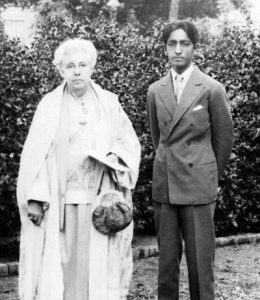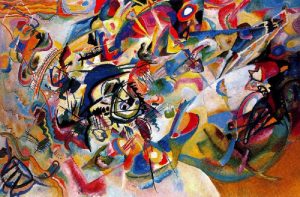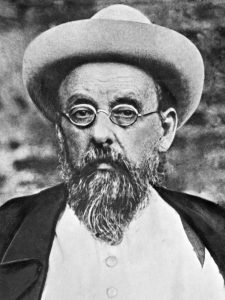The world seems to be on fire. Terrifying, yet amazing changes are ahead, and there is the general sentiment that it is just the beginning. Starting afresh, starting a new life, a new world order, a new paradigm for humanity – these occupy people especially in the past decade, when the impacts of climate change topped with a global pandemic and breakout of wars in the premises of the ‘civilized world’ are urging us to live life not only completely differently in practice, but with a radically different attitude as well.
It seems like the 21st century is inventing tons of new practices for a new future and are already putting them in place. Just what tendencies define the western collective fantasy today and what kind of future do they anticipate? In the followings, I will give a brief overview on how we are creating a new reality as a response to the challenges we face, and by introducing a historical example of the early 20th century, I question whether what drives us today can be claimed the novelty of the present.(1)
If we think of western culture as the potential infuencer of the future of the world, the happenings and ideologies of the west should be explored. The bottom line the west claims to be the joint vision for the 21st century human society is defined by a sustainable, egalitarian, democratic, globalized world view, in which there is:
Gender equality: there should be equality among genders, gender roles as such should either cease to exist as distinctive practices or difference must be completely respected and must not be understood in a hierarchical value system. Gender fluidity is a tendency among the youth, wokism is thriving, non-binary and transgender identities are part of the collective fantasy that can be easily used for any political propaganda, liberal and conservative. The idea of the beautiful is being reinterpreted, being sexual appears to be socially insulting, yet at the same time there are no limits to nudity, celebrities walk around naked.

Equality among species: The 21st century human must be close to nature, must have a spiritual connection to the natural world, animals and fellow human being of all races, culture and heritage. Veganism is the new, non-violent practice for saving the planet and nourishing the population of a demographic boom. Sustainable, eco, green planet-saving practices are the new status quo.
Spirituality: In terms of spiritual practices, there is pretty much every version of relating to a supernatural. There is vehement atheism (denial), there is traditional religious thought connected to the roots and the local, there is holistic thinking based on the 1960s New Ageism, there are pure eastern practices of any yogic tradition, meditation, zen, there is even the fusion of the Judeo-Christian tradition with the east. The impact of the east has become so prevalent, that words such as reincarnation, karma, enlightenment go almost as clichées. The Dalai Lama is a key spiritual authority for westerners, and the aforementioned Vedic expressions find their 21st century couterparts in mindfulness, presentism, meditation. Gurus such as Eckhardt Tolle fill up stadiums. All this is more than just superficial mumbo-jumbo: for many there is a genuine craving to holistically live a happy life, to understand and see their place in the world, or at least to step out of the suffering that lies underneath an ever-burdensome human condition.
Global citizens: Globalization through technology is creating a truly interconnected planet, migrations across borders and the integration of societies into the other as brotherhoods based on empathy still stand as the basis of a European identity. Although localities have some kind of nostalgic flavor that calls for protection, the great melting-pot and the erasure of national identity, or the development of the identity of a global citizen takes over the protection of national particularities. Social media results in even further abolishing of differences and localities, yet creates new identities with questionable depth.
Technology as solution: The gender-fluid global citizen identifying with other-than-human life expands even further with the help of technology. Biomedicine is reaching incredible heights in body-transformation. Stem-cell research to prevent growing old, expanding life expectancy to about 120, or even the transformation of brain content into a computer is being heavily researched now, not even talking about robotic bodyparts that function a hundred times more efficiently than – the presumably lost, damaged or simply disliked – natural ones. Space travel and inhabiting space is not only of primary interest of the governments of states, but of private individuals who run companies in order to fund their space research programs (Elon Must or Jeff Bessos).

The list could go on, but for now let me just stick to these key points. Although it seems like we are inventing a new reality, that in many ways – predominantly because of the technological advancements we have achieved – is indeed new, the fantasy that defines these practices has been around for sometime. It recurs in history, and one of its interesting faces manifested a 100 years ago in Russia.
The 1910s and 20s saw very similar solutions to ours, both spiritual and physical, for solving the ‘issues of the human condition’. The spirit of the modernist avant-garde pretty much across the colonial world and Russia was aiming for a very similar reality we are living in today.
In the beginning of the 1900s, scientific development, a growing atheism, yet thriving spiritual practices influenced by the colonial East, especially India and its yoga tradition made a huge impact on Europe. A newfound spiritual clarity that peeked in practices such as the Theosophical Society, lead by the Russian Helena Blavatsky and the English Annie Besant and Anthony Leadbeater, created a complex movement based on the Indian figure of Krishnamurti. This strange combination of vedic spiritualism, esoteric practices and science influenced many artists and thinkers.

The spiritual movement that drew from Christianity as much as from the yoga tradition influenced a great number of artists, such as Wassily Kandinsky or Johannes Itten, and made an impact even on complex artistic movements such as the Bauhaus.

Although initially it was an atheistic approach, the idea of communism, calling for equality of classes and genders was happily adopted by the avant-garde youth especially in Russia by young thinkers, artist, scientists and the people of course, who had suffered the most brutal hardships of aristocratic exploitation and malmanagement of resources, famine, poverty, destitution.

Although most of them agreed with the basic econimical theory of Marxism, and supported the science and social restructuring – including the rewriting of gender-roles, the development of internationalism – vehemently proposed by communists, the artists and thinkers engaging with communism in Russia were far from materialistic. Malevich, Tatlin, Rodchenko, Alters, Kandinsky claimed that in communism God is manifesting in its evolutionary form: the third heavenly kingdom is about to arrive to Russia, and its form of state is going to be communism. Furthermore, the aesthetic principles they were following (mostly geometrical abstraction) was the manifestation of this godly order. Malevich’s Suprematism was no other than God-painting, the evolution of the Russian Orthodox icon, where God loses all traditional form, it even loses its silver of gold light and becomes the black square, void, which is actually a spiritual experience in mysticism. „Malevich ‘White on White’ reveals itself as not just a painting, but a profound exploration of infinity, purity, and the very essence of artistry.”(2)
Although this facet of the avant-garde is pretty well-known, the movement called Cosmism is less in the mainstream general knowledge. The Russian avant-garde was closely tied to this religio-philosophical movement. Nikolai Fedorov (1827-1903), one of the founding fathers of the movement claimed that humankind is heading for eternal life, and the goal of science is to find the material solution for eternal life. In this sense, bodily resurrection was a scientific issue, a problem that can be solved by science following godly inspiration. Certainly, according to Fedorov, if death ceases to be the case, the planet will become overpopulated, so – he claimed – space travel and the populating of distant planets will become inevitable. Therefore, the name Cosmism was given. (3)
These ideas did not only resonate with the early modernist intellectual circles who thought of themselves as the pioneers of a new world order defined by science. Doctors and scientists experimented with the implementation of immortality and mathematicians made research that later served the basis of the Soviet space program. Alexander Bogdanov’s invention of blood transfusion sprang from this spirit.
Although experiments as such were strongly scientific and materialistic, in Russia philosophers such as Fedorov himself were deeply religious, rooted in the Russian Orthodox faith. Konstantin Tsiolkovsky for instance, another central figure of the movement, a self-taught scientist who was actually the first to develop mathematical formulas for a spaceship to leave the orbit of the Earth, was a devout Orthodox Christian. Born in 1857, he came from a simple family living of a family of 17 siblings in rural Russia. He lost his hearing at the age of 10 and was forced to stay away from school, He homeschooled himself from that time on, and appeared to be so brilliant that they found a way to send him to study in Moscow under Fedorov. Just how important his contributions were to the directions we are heading towards today, is shown by the fact that fellow scientist consider him to be the founding father of austronatics, “It is Tsiolkovsky who first determined that the escape velocity from the Earth into orbit was 8 km/second and that this could be achieved by using a multi-stage rocket fueled by liquid oxygen and liquid hydrogen. During his lifetime he published over 500 works on space travel…”(4)

For him, science was a discovery of the magical world created by God, so he came up with ideas that are not very far from today’s quantum physics and might be in line with the records of past-life experiences. He thought that death was an ecstatic moment, when the atoms and energy bound by form become liberated and return to the great cosmos and creator. He thought that mater has consciousness, and there is an omnipresent sentient spirit in the things seen and unseen. He writes: „Death is one of the illusions of the weak human mind. Death does not exist…The universe is constructed in such a way that not only [it] itself is immortal, but also all of its parts, in the form of living, blessed beings. There is no beginning and no end to the universe, and thus no beginning and no end to life and to bliss.”(5)
So Cosmism today is referred to as the first movement of God-building. In their essay God-building as a work of art: cosmist aesthetics Anton Vidokle and Irmrard Emmelhainz (2020 june e-flux no. 110.) argue: “Some key communist leaders such as Anatoly Lunacharsky, the first People’s Commissar for education in the Soviet Union, supported and wrote extensively on this idea. … ‘For the sake of the great struggle for life… it is necessary for humanity to almost organically merge into an integral unity. Not a mechanical or chemical… but a psychic, consciously emotional linking-together… is in fact a religious emotion,’ writes Lunacharsky in Religion and Socialism in 1908.
Do we see a connection along these lines then and today? Gender, global, scientific, salvatory, spiritual? Isn’t it interesting that people find and create the same liberating fantasies over and over again, certainly in a different coating, but the bottomline appears to be quite the same. Yet, I believe we are not just repeating history, but there are lessons to learn.
What is it that we can learn from the cosmists and their avant-garde fellow artists? To me it is their humility. People will not stop growing, change and growth cannot be halted. But the awe that is in the world that we can experience when we are looking at it, taken by all the wonder, greatness, and infinity of creation is something that we should be open to all the time. This leads to humbleness, this is what the cosmist scientists and artists practiced: to stay open for the magic of creation. Maybe this humility is something we should absorb before we eject our naked girlfriends into space.
Notes:
(1) I am aware that describing the collective human fantasy of the 21st century human being within the limitations of a blogpost is almost impossible, but let’s see if some key points can be identified at all.
(2) https://kazimirmalevich.org/white-on-white/
(3) https://iep.utm.edu/fedorov/
(5) https://www.palladiummag.com/2023/08/24/a-new-cosmist-moment/
(the text was inspired by the New Start. Masterpieces from twenty-fine pioneering artists exhibition. HAB, Budapest, January 23-April 7 2024.)